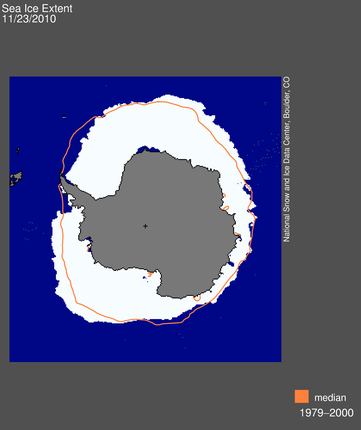From the NSIDC image, it appears that there is a large amount of excess sea ice bordering West Antarctica (lower left.)
What you can’t see is that super-secret stealth currents of warm water travel hundreds of miles under the ice, then drill up to the surface and attack the WAIS. Their plan is cause collapse of the ice sheet and cause 15 metres of sea level rise.
Only higher taxes can stop them at this point.



With more resolution
http://www.iup.uni-bremen.de:8084/amsr/antarctic_AMSRE_nic.png
very swiss cheese like.
On the other hand, no swiss cheese with the big hole in the arctic basin between Alaska and Russia
http://www.iup.uni-bremen.de:8084/amsr/arctic_AMSRE_nic.png
Andy
very swiss cheese like.
Very normal like.
I am not paying its blackmail
I believe the correct construction of the meaning would be something akin to explaining the ice difference today compared to 1979-2000 mean.
If you include the actual whole of west antarctica, per your generalization, there doesn’t seem to have been any ice loss what so ever.
And talking about ice loss, why is everyone so fixated with that the ice is lost? Disregarding the fact that technically speaking it isn’t really lost, just transformed into a new format, so to speak, lol.
Concerning only the missing part. Was it there before prior to 1979? If so, for how long? And if it was there for “that long” is that long enough to conclude it has “always” been there, so that it now can be considered to actually be “lost”?
Will that missing part form again? Before or at least equal to the time referenced with “that long”. Then what’s the problem?
Cheers
I saw the pictures of the missing ice on milk cartons last week so there must be a search and rescue effort out for the “Missing” ice. It may have been a domestic abduction or an ice molester may be loose. Make sure your ice is kept safe and do not let it go out walking alone.
Long term Natural ocean atmosphere weather patterns account for variations in the ice around Antarctica. Geothermal activity accounts for warm water in the region along with natural warm water currents flowing out of the Pacific
Only higher taxes can stop them at this point.
And a law with some politicians name on it so he can take credit for what Nature does.
How can you look at the ice diagram and believe the “official” number that Antarctic ice is only 280,000 Km2 above the 30 year norm?? Looks like it must be a lot more to me.
Levels of carbon dioxide in the atmosphere are now 35% higher than they have been at any time in the past 800,000 years. They are continuing to increase at a rate 100 times faster than any other significant change seen in the ice core record.
Glaciologist Dr Robert Mulvaney, from the British Antarctic Survey, who has collected ice cores for more than 25 years, said: “The climate has almost certainly not yet had time to respond fully to this sudden and rapid rise in carbon dioxide.
“Ice cores have allowed us to see in detail that greenhouse gases are so well related to temperature and have brought the world’s attention to the fact that carbon dioxide and methane levels are now at levels far higher than they’ve ever been in the last 800,000 years.”
that carbon dioxide and methane levels are now at levels far higher than they’ve ever been in the last 800,000 years.
so burning hydrocarbons releases methane as well as CO2?
Sarah:
He forgot a minor issue: Historically warming temperatures lead to increased CO2 and Methane levels due to increased biological activity. Climate does not respond to minor changes in CO2. CO2 or rather Biological Activity responds to any changes in climate.
I would not be so certain that current levels of those gasses are really at the highest levels in 800 thousand years as some of the other claims have been shown to be not quite correct.